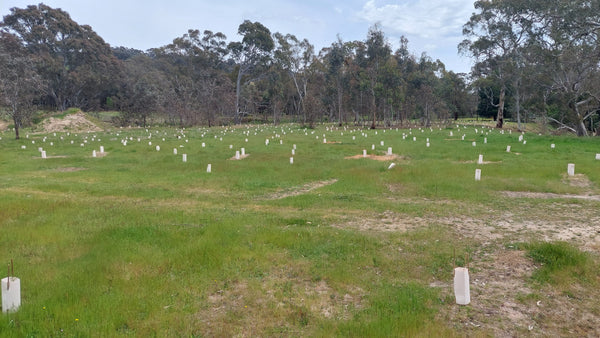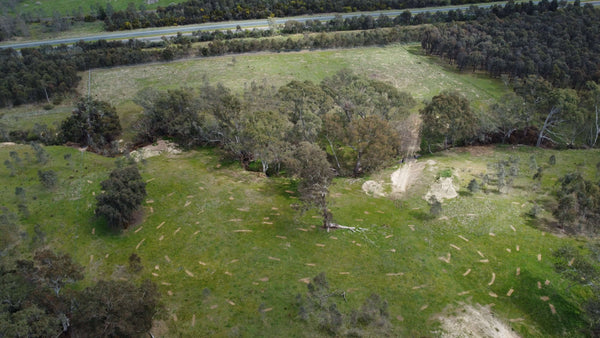Delivering Climate Action And Restoring Native Woodlands
Located on Dja Dja Wurrung Country in Central Victoria, Harmony Way was previously cleared for grazing. By revegetating this property, Greenfleet is contributing to the recovery of Low Rise Grassy Woodland, a vegetation community listed as vulnerable.
While delivering climate action, this forest will also build and extend habitat for many native wildlife species, including the squirrel glider, regent honeyeater and brush-tailed phascogale. Some of the species already found on the site that will benefit from this revegetation work include kangaroos, corellas and sulphur-crested cockatoos.

Location & Map
Located on the lands of the Dja Dja Wurrung people, Harmony way is locatedjust out of Castlemaine in Central Victoria. The native ecosystems that thrived in this region prior to land clearing are characterised by open eucalypt woodlands that can grow up to 15 metres in height.

Plant Species Selection & Revegetation Approach
16 different plant species were restored at Harmony Way in 2023. While delivering climate action, this revegetation project will assist in the restoration of Ecological Vegetation Classes (EVCs), including Low Rise Grassy Woodland, Alluvial Terraces Herb-rich Woodland, and Creekline Grassy Woodland.
The selection of locally native species that make up these ecosystem types include river red gum (Eucalyptus camaldulensis), buloke (Allocasuarina luehmanni) and spreading wattle (Acacia genistifolia); a hardy plant that attracts nectar eating birds and insects.
At Harmony Way, the trees and plants were planted directly into the soil and guarded to help alleviate browsing pressure for the newly planted seedlings. As the trees become more established and browsing now longer poses a risk, we will remove the guards from the site.
There was good rainfall at the time of planting which helps in the initial establishment of the trees. There were dry periods in this region in the second half of 2023, however the site experienced significant rainfall in December of that year.

Habitat Restoration
While carbon offsetting has funded the work being completed at Harmony Way, the outcome is a legally protected native forest. As it grows, it will provide protected habitat for native wildlife to move throughout the area safely.
Kangaroos, corellas and sulphur-crested cockatoos can already be found at Harmony Way, and the revegetation work will build potential habitat for species such as the brush-tailed phascogale, squirrel glider, and the regent honeyeater which is critically endangered.
These striking birds can be identified by their black and yellow plumage and need eucalypt forests and woodlands to survive. Tree species such as yellow gum (Eucalyptus leucoxylon) and yellow box (Eucalyptus melliodora) will provide habitat for these incredible birds.
Climate Action
This forest is legally protected for 100 years. Over its lifetime, it will capture over 4,000 tonnes of carbon from the atmosphere, which equates to removing approximately 1,000 average cars from Australia’s roads for a whole year.
To measure the carbon uptake of our revegetation projects, Greenfleet uses the Full Carbon Accounting Method (FullCAM). This model was developed by the CSIRO and is approved by the Department of Climate Change, Energy, the Environment and Water.
Location
7 hectares near Castlemaine, Victoria.
Planting Dates
2023
Species Planted
- Silver wattle (Acacia dealbata)
- Spreading wattle (Acacia genistifolia)
- Black wattle (Acacia mearnsii)
- Blackwood (Acacia melanoxylon)
- Mallee wattle (Acacia montana)
- Kangaroo thorn (Acacia paradoxa)
- Swamp wattle (Acacia provincialis)
- Buloke (Allocasuarina luehmannii)
- River bottlebrush (Callistemon sieberi)
- Wedge-leaf hop-bush (Dodonaea viscosa subsp. cuneata)
- River red gum (Eucalyptus camaldulensis)
- Long-leaved box (Eucalyptus goniocalyx)
- Yellow box (Eucalyptus melliodora)
- Grey box (Eucalyptus microcarpa)
- Yellow gum (Eucalyptus leucoxylon)
- River tea-tree (Melaleuca parvistaminea)


